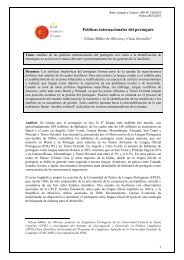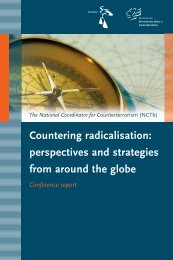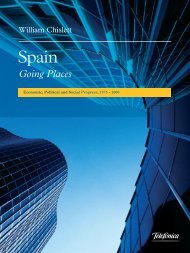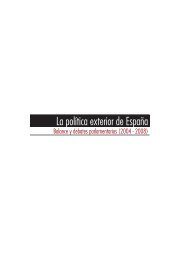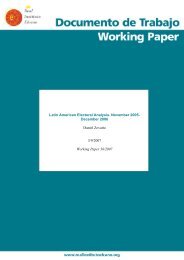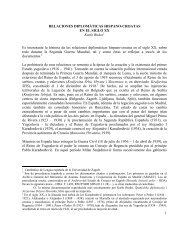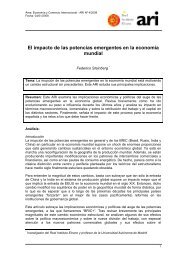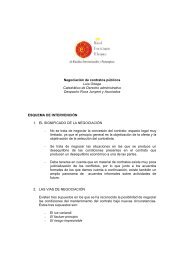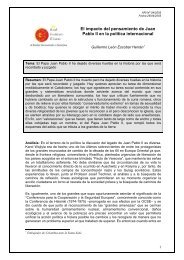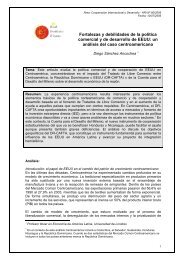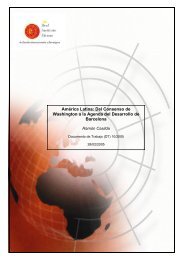Spain and the United States - Real Instituto Elcano
Spain and the United States - Real Instituto Elcano
Spain and the United States - Real Instituto Elcano
You also want an ePaper? Increase the reach of your titles
YUMPU automatically turns print PDFs into web optimized ePapers that Google loves.
OVERVIEW 23<br />
The position of <strong>the</strong> Eisenhower administration was “to grant <strong>Spain</strong> <strong>the</strong><br />
minimum amount of additional economic aid necessary to ensure internal<br />
stability so that <strong>the</strong> use of our bases <strong>the</strong>re would not be jeopardised by civil<br />
disorders.” 20 This explains <strong>the</strong> continuous American concern about inflation,<br />
because <strong>the</strong> more it rose <strong>the</strong> greater <strong>the</strong> potential for unrest in <strong>Spain</strong>. The<br />
Spanish government took this point on board.<br />
Ano<strong>the</strong>r element of <strong>the</strong> aid package was defence support. This totalled<br />
$488 million between 1954 <strong>and</strong> 1964. It was initially used for foodstuffs, coal,<br />
cotton <strong>and</strong> o<strong>the</strong>r inputs <strong>and</strong> capital goods <strong>and</strong> from 1958 for development<br />
projects. This aid generated a counterpart fund in pesetas, a mechanism also<br />
used in <strong>the</strong> Marshall Plan. The government was required to pay in pesetas <strong>the</strong><br />
equivalent value of dollars received, using a specified exchange rate of 35<br />
pesetas per dollar. The percentage of counterpart funds to be used by <strong>the</strong><br />
Americans was fixed at 70% (60% to finance <strong>the</strong> base construction programme<br />
<strong>and</strong> 10% for administrative expenses in <strong>Spain</strong>). Marshall Fund recipients, in<br />
contrast, were able to use 90% of counterpart funds (as opposed to <strong>Spain</strong>’s<br />
30%) to develop <strong>the</strong>ir economies.<br />
The provision of agricultural surpluses under <strong>the</strong> aid programme started, as<br />
we have seen, before <strong>the</strong> signing of <strong>the</strong> Pact of Madrid in 1953. <strong>Spain</strong> received<br />
close to $500 million under all <strong>the</strong> mechanisms envisaged in Public Law 480<br />
(PL480), a sales programme in which agricultural surpluses were exchanged<br />
for local currency to be used by <strong>the</strong> American legations in <strong>the</strong> field.<br />
Lastly, o<strong>the</strong>r elements of <strong>the</strong> aid programme included <strong>the</strong> donation of<br />
foodstuffs through PL480 (distributed by Cáritas) <strong>and</strong> military aid, which took<br />
<strong>the</strong> form of deliveries of items to <strong>the</strong> armed forces. The value of <strong>the</strong>se items<br />
was more than $300 million.<br />
The economic assistance programme committed <strong>Spain</strong> to “stabilise its<br />
currency, establish or maintain a valid rate of exchange, balance its<br />
government budget as soon as practicable, create or maintain internal financial<br />
stability, <strong>and</strong> generally restore or maintain confidence in its monetary system”,<br />
as well as “discourage cartel or monopolistic business practices <strong>and</strong> business<br />
arrangements which result in restricting production <strong>and</strong> increasing prices or<br />
which curtail international trade, encourage competition <strong>and</strong> productivity <strong>and</strong><br />
facilitate <strong>and</strong> stimulate <strong>the</strong> growth of international trade by reducing barriers”.<br />
In o<strong>the</strong>r words, create a market economy. Had <strong>the</strong>se conditions, which were in<br />
stark contrast to <strong>Spain</strong>’s policies at <strong>the</strong> time, been rigorously enforced, <strong>the</strong><br />
impact would have been dramatic <strong>and</strong> probably undermined <strong>the</strong> regime. The<br />
regime initially paid scant attention to <strong>the</strong>m. Over <strong>the</strong> long term, however, it<br />
20. See Memor<strong>and</strong>um of Discussion at <strong>the</strong> 248th Meeting of <strong>the</strong> National Security Council”, May 12,<br />
1955. FRUS, 1955-57, XXVII, p. 537.



